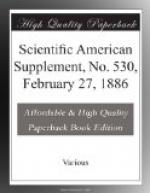Cyanin and eosine mixtures I give in the following proportions;
III. 0.5 grm. cyanin (iodo-cyanin) dissolved in 1,000 c.c. alcohol under good shaking.
(All coloring matter solutions have to be filtered.)
To 1,000 c.c. Monckhoven emulsion I give:
25 c.c. eosine solution, yellow shade (I.).
5 c.c. cyanine solution (III.).
With Henderson emulsion I increase to double the quantity.
Further experiments taught me that even if 60 to 80 c.c., and more, of these coloring matter solutions were added, and the emulsion was left to coagulate and then laid in alcohol for several days, after which it was washed well, so that hardly any coloration could be observed, it showed, when making a copy of an oil painting, that the color sensitiveness of the emulsion was not reduced, and that it had rather increased in relative sensitiveness.
Anyhow, I put every colored emulsion for eight days in alcohol, having experienced that hereby, after washing, just a sufficient quantity of the coloring matter will remain as is necessary for the color sensitiveness.
For the correctness of what I have said here, the following experiment made by me will speak:
I mixed with an emulsion a quantity of coloring matter five times increased, flowed a plate with same, which I then exposed, but obtained no picture whatever.
The same emulsion I placed for fourteen days in alcohol, washed it well, and flowed a plate again, which latter had not only the full color sensitiveness, but almost equaled an ordinary emulsion plate in total sensitiveness.
From this can be concluded that—as above said—by placing the emulsion in alcohol, all superfluous coloring matter is removed from the same, and that only the quantity necessary for the color sensitiveness remains therein.
Further, it may be mentioned that it might be of advantage to add to all emulsions eosine besides iodide of silver, because this will give to the emulsion clearness and brilliancy besides color sensitiveness, and produce fine lights.
Finally, I express the hope that these communications may be useful to the practical photographer, and it is my intention to report also about other coloring matters at some future time.—H.D., in Anthony’s Bulletin.
* * * * *
A NEW PHOTOGRAPHIC APPARATUS.
This apparatus consists of a box containing a camera, A, and a frame, C, containing the desired number of plates, each held in a small frame of black Bristol board. The camera contains a mirror, M, which pivots upon an axis and is maneuvered by the extreme bottom, B. This mirror stops at an angle of 45 deg., and sends the image coming from the objective to the horizontal plate, D, at the upper part of the camera. The image thus reflected is righted upon this plate.




